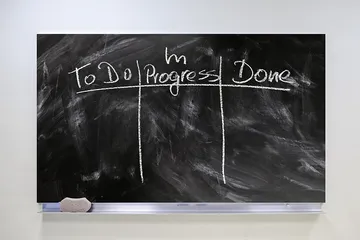So You Want to Try Agile?

Haley Johnson, Former Product Manager
Article Categories:
Posted on
Before applying agile to your marketing site build, do this.
Earlier this year, under extreme urgency, we helped Ad Council launch its COVID-19 vaccine website. Prior to launch, vaccine skepticism was at its highest and news around the pandemic changed daily. This site offers a trusted and impartial resource for the millions of Americans with questions about the vaccines. Due to the timing of the rollout, this site needed to launch months before vaccines were actually available to the general public. It also needed flexibility, operating within the realities of changing information and a tight timeline. Because of this, we switched from the traditional waterfall approach of scoping all requirements ahead of time to embrace a more "agile" process.
As we’ve discussed before, it’s difficult to pin down exactly what agile means. When Ad Council approached us, their two primary goals were speed and iteration. But they weren’t bringing an application to market—they wanted to launch a content site as quickly as possible. For three months following launch, they wanted to iterate, adapting it based on stakeholder feedback, UX research, and data analytics. This would allow them to arrive at a data-informed version of their site that worked best for both stakeholders and users, which could also change over time as vaccine news evolved.
So for the purposes of this article, when I use the term ‘agile,’ I’m referring to the principles that allow for constantly changing requirements and an uninterrupted pace of work.
There can be challenges when applying a framework for software development to something as technically uncomplicated (code-wise) yet volatile (rapidly changing content) as a content site. Thankfully, there are companies who coach marketing organizations into adopting agile principles. This article is not a summary of their work. Adapting a framework for custom development to work for all project processes feels like trying to affix a motor to a skateboard—it works, it just feels a little hacky.
Should you decide that you’d like to dip your toes in the agile world with your next content site, these guardrails can help you experiment with the process somewhat painlessly.
Do you have an open scope and an open budget?
Providing a team with an open scope means giving them the agency to pull in all available resources to respond to changing requirements. This is only possible with a flexible budget. You could also consider paying a fixed weekly rate to have a team work quickly and launch whatever they can in a specified timeframe. Agile is about being adaptable to changing requirements, and having a fixed budget stymies that flexibility to adapt.
Do you use a ticketing tool or kanban board?
To stay organized, use a tool that facilitates quick scoping, prioritization, and communication. This will be your project team’s primary source of truth for tasks.
We used a kanban board with a few different “swim lanes” for this particular project. We found that the following configuration allowed for stakeholder feedback while also working quickly:
- Backlog - where tasks live before they’re fully scoped.
- Needs Scoping - where questions or requirements are clarified.
- Up Next - when the task is ready to be worked on.
- In Progress - when the task is being worked on.
- Ready for Internal QA - when we’re ready for the internal project team to review.
- Ready for Client QA - when we’re ready for the client team to review.
- Blocked - when a task can not be worked on.
- Complete - when a task is done.

We used due dates as a means for prioritizing. Each task received a due date once it left the Backlog. In our case, we had multiple departments (design, content, development) in our board. One owner on our team and one owner on the Ad Council team triaged and assigned the tasks as they came in, checking in on overdue tasks and checking off completed ones. These owners also enforced our processes -- from how we formatted requests to how we handled orphaned tasks. The board was our source of truth, which we pulled up during every standup meeting.
If there’s an agile framework that just isn’t working for your team and the flow of work, it’s okay to abandon it for a better way.
If you’re looking for a tool to organize your fledging agile team, check out the following:
Do you have flexibility to adjust your planning approach based on the evolving needs of the project?
In the spirit of scrum (an agile framework), we started with two-week sprints. Each sprint began with a planning meeting, continued with daily standups, and ended with a retrospective. Due to the rapidly changing content of our project, our loosely defined requirements quickly changed. Ad Council’s agile coach called these disruptions “bombs.” Our sprint plan was useless because we couldn’t stay focused on the same direction for two straight weeks. So we adjusted, switching to a weekly cadence of planning our work. We also added weekly planning meetings with higher-level stakeholders at the end of each week so we could get ahead of emergent requests.
If there’s an agile framework that just isn’t working for your team and the flow of work, it’s okay to abandon it for a better way.
Do you have a tool and process to wrangle content?
Getting review on content is the most nefarious task to adapt to agile principles. When you’re sprinting towards a deadline and your data is changing constantly and your subject-matter experts are swamped, content can easily lag behind. Imagine sending content for review, only to have the layout of one component change and render parts of that content non-existent. Most ticketing tools, with the exception of Airtable, aren’t robust enough to handle version control at a high level of granularity. In fact, many of our well-intentioned content spreadsheets broke under the sheer volume of stakeholder feedback. If you’re going to use a content spreadsheet or Airtable, designate an owner who can manage the tool and maintain a consistent process. This person could make sure that there’s a column for copy-edits in lieu of using comment threads. There are also software tools that allegedly make the content review process much easier.
Still think you want to try agile on your marketing site?
An agile process isn't always necessary for some marketing site builds. But if you're looking for speed and iteration, this process could be beneficial. Just allow yourself a little grace and be prepared to adjust your plan. It’s kind of exhilarating to make that motorized skateboard finally work.